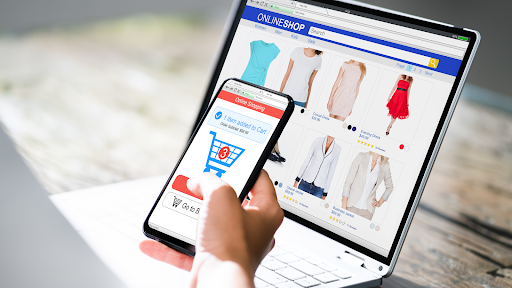Used by world leaders and regular citizens alike, Twitter is a social media platform that has undeniably transformed the way that humans interact. While this may seem hyperbolic, Twitter has created a language – initially in 140 characters or less – that has defined digital, person-to-person interactions more so than any other platform that came before.
The brainchild of programmers Jack Dorsey (@Jack), Evan Williams (@Ev) and Biz Stone (@Biz), the dictionary definition of twitter is “a short burst of inconsequential information”; tweets serving as the platform’s information vessel.
Defined more as “micro-blogging” with its now-280 character limit, Twitter boasts over 313 million monthly users, making it one of the “Big 3” social networks alongside Facebook and Instagram. A useful platform for both B2C and B2B communications, those millions of users send 6,000 tweets per second—resulting in more than half a billion per day—and are three times more likely than Facebook users to follow a brand.
As with any social media platform, Twitter has an ever-changing algorithm that is modified frequently to suit the needs of its users. Currently, the Twitter timeline consists of three main sections: Ranked tweets, “in case you missed it”, and remaining tweets in reverse-chronological order. To determine how tweets are separated into these three categories in your feed, Twitter will look at the following:
- The Tweet: its recency, presence of media cards (image or video), and overall engagement (including retweets, clicks, favorites, and time spent reading it).
- The Author: your past interactions with this author, the strength of your connection to them, and the origin of your relationship.
- Level of Interest: tweets you found engaging in the past, how often and how heavily you use Twitter.
Given these guidelines, it’s best to identify your objectives and set your strategy before sending off a barrage of likes and retweets. Develop an outline of what your target audience wants, and know who your target persona is, exactly. What are they liking? Who are they following? What drives their interaction on Twitter?
If you’re late to the Twitter game, or are not seeing the results you hoped for, we have a few guidelines that will help to boost your traffic and, in turn, boost your sales:
1. Develop your brand’s voice
It goes without saying that “internet” language can be fun, but should be left out of any business-related conversation. Develop a distinct brand voice that is easily recognizable to all coming to your page in order to keep them fully engaged.
In addition, use emoticons and emojis sparsely; not all conversation require a smiley face or a thumbs up. Make sure that all your tweets, replies, and retweets are grammatically correct as well. Given that you will be following CEO, CMOs, influencers, and publications that pertain to your industry, the last thing you want is for someone outside of your company to catch a typo.
Here’s an example of how the formerly-stodgy @MerriamWebster has developed a smart voice that has garnered over 650,000 followers:
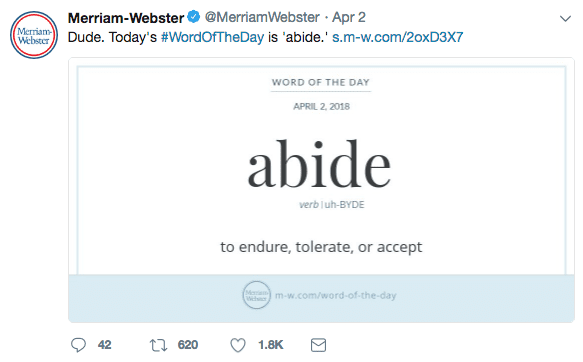
2. Show off your expertise
With an abundance of users online everyday, it becomes increasingly difficult to stand out from the pack. Getting verified (otherwise known as the blue check-mark to the right side of your name) is a great way to establish your brand as one of importance. Another way to highlight your credentials without being overbearing is by listing your various companies, endeavours, or accomplishments in your bio along with your website. Here’s an example of Guy Kawasaki and Kim Garst’s personal Twitter accounts below:
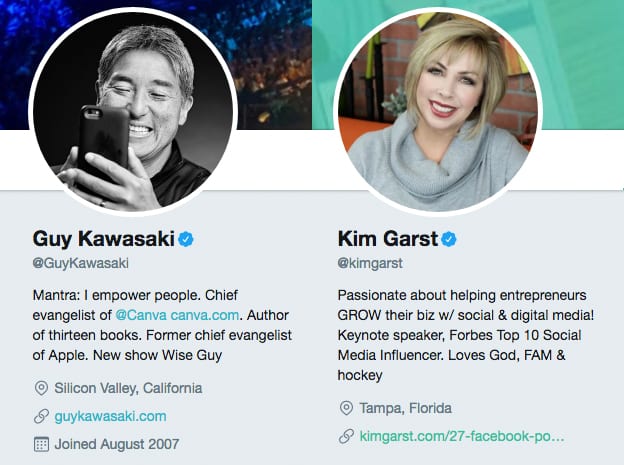
Another way to demonstrate your expertise is by creating and joining groups and forums. Much like LinkedIn’s groups feature, Twitter users can participate in lively discussions and contribute to conversations that extend beyond the Twitter verse. And one rule of thumb when it comes to Twitter: respond in a timely manner. This shows that you are open and available to communication.
3. Curate your content
While it’s tempting to tweet a cute GIF or zippy one-liner in place of a thought-out tweet, make sure that you are always putting out quality content that’s in line with your brand’s vision. Beyond creating a content calendar, stay up-to-date on any information that pertains to your industry. Retweet any credible sources that will heighten your page in some way. Link any of your blogs, articles, and tweet mentions to major sites or publications for maximum reach.
In addition, if you see that a tweet is performing well: pin it! Pinning a tweet will allow it to appear as your top post for as long as you deem fit. Sharing your posts more than once will also help give your content its due diligence. If you want to take your content one step further, try “promoting” your tweet. While this comes at a cost, it remains an important way to get your message across.
When it comes to hashtags, try to use them only when necessary. While it may be tempting to stuff hashtags into the new 280-character box, make sure that you’re not inundating your audience with too much information. One example of great curation paired with a distinct customer voice can be seen with Digital Doughnut here:
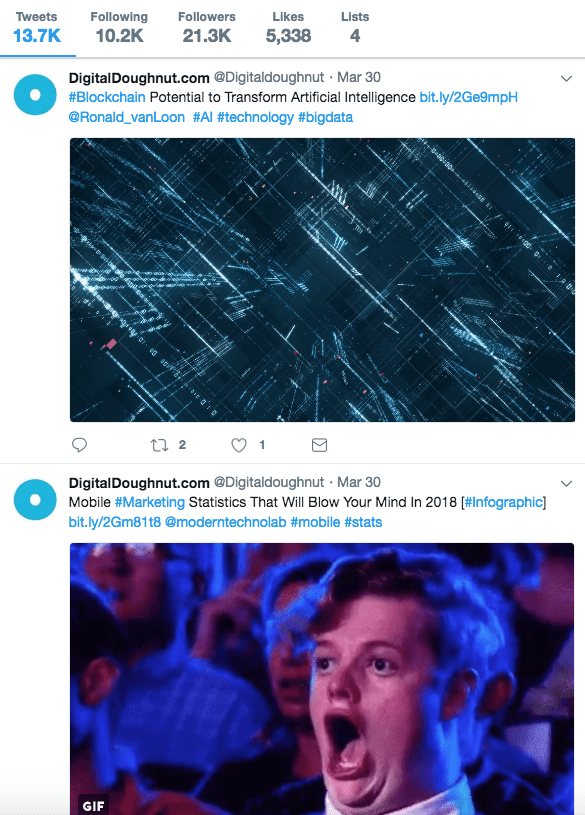
4. Keep it visual
Sometimes images get the message across better than words. Use GIFs, videos, memes, and still images when appropriate in order to gain maximum impact with your posts. Pair visual media with your latest article or blog post, and you will, categorically, get more views.
Adding a branded background image will also solidify your brand’s Twitter presence. See an example of the New Yorker’s Twitter page below. In this example, the publication’s voice and style comes across brilliantly – without having to “say” anything:
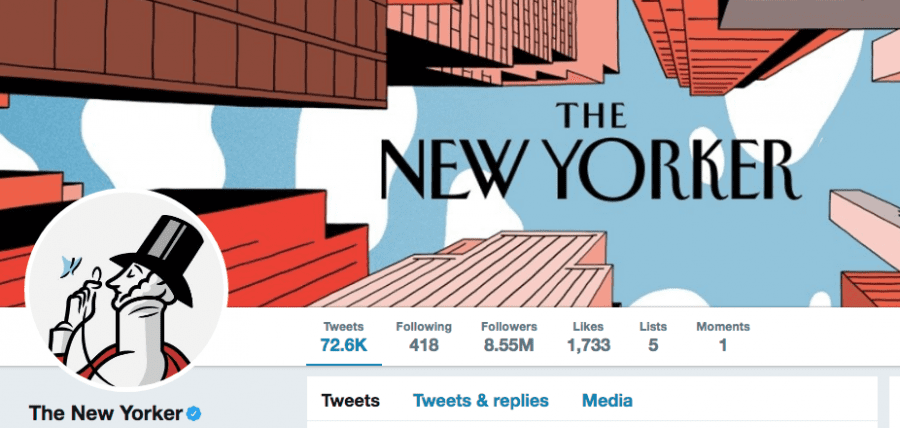
5. Partner with influencers
With an extensive reach and a community of committed followers, these social media experts are able to spread the word of your brand in an indirect way; resulting in a promotion that looks casual and organic, rather than pushy. Whether in the form of a simple retweet or a full-fledged campaign, influencers can help you gain a lot of traction.
6. Create twitter-specific ads
Broken down into Promoted Tweets, Promoted Accounts, and Promoted Trends, Twitter ads are a quick way to get your message directly onto a consumer’s feed. Clearly marked with a “promoted” icon, users are able to interact with most promoted content in much the same way as organic content. If you follow, like, or Retweet content on Twitter, including promoted content, your followers may see your name associated with that content.
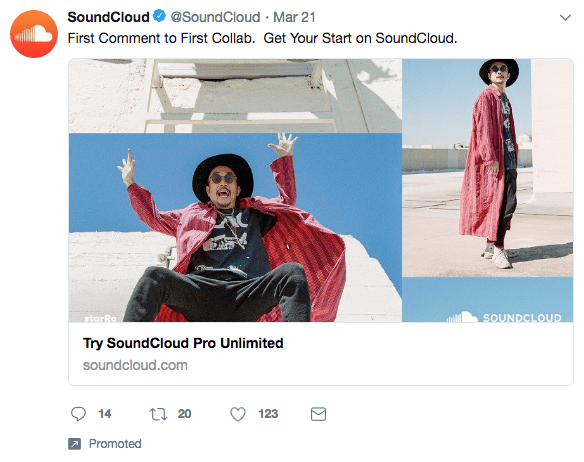
7. Create engagement incentives
Much like lead generation, once you capture that follower, you have to nurture their experience. Try hosting social media contests and/or giveaways to keep your audience engaged. In addition, try conducting polls and asking questions of your audience. Show your followers that you trust and value their judgement. And like the AirBnb example below, don’t be afraid to make the experience fun!
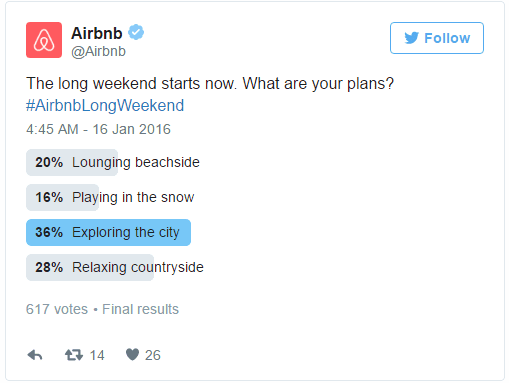
8. Exchange traffic with your website
Create a little cross-pollination between your website and Twitter account by embedding a “follow” button and/or put a timeline widget on your webpage. In addition, from Twitter, mention your website frequently in order to direct them back to your source, while also listing your domain in your main biography. Linking back to all articles that pertain to your website is a great way to generate leads.
9. Maintain a schedule
Even though posting frequently is recommended, developing a set schedule is a must. While this varies according to your industry, scheduling on a set time of day will help your page to have a set rhythm – one which your followers can monitor. Reposting or retweeting your top tweets can also be scheduled on a calendar—especially with the help of a marketing automation.
10. Analyze Your Performance
Monitoring and analyzing the performance of each individual tweet, and of your page as a whole, is of the utmost importance. The easier way to do so would be through Twitter’s own Business Analytics. This summarizes your performance in a concise report.
And, of course, marketing automation is an excellent way to have all your social platform analytics (not just Twitter) all in one place.
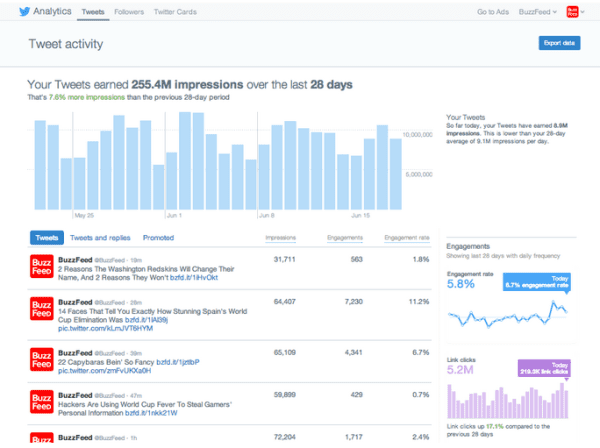
There are a multitude of ways to optimize your Twitter experience. Utilize the tools at your disposal in order to facilitate a fun, fresh, and informative experience for each one of your follows, whether they be B2C or B2B.
Don’t forget to share this article

